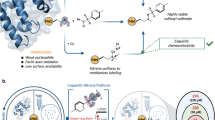Abstract
Purpose. To establish the sensitivity of Zn2+ insulin (Zn2+-INS) to metal-catalyzed oxidation (MCO) and to use tandem mass spectrometry/mass spectroscopy (MS/MS) for the identification and quantification of 2-oxo-histidine at 5HisB and 10HisB upon the MCO of INS.
Methods. Zn2+-INS was exposed to Cu2+/ascorbate-induced MCO. Products were analyzed by reverse-phase high-performance liquid chromatography, electrospray ionization mass spectrometry (ESI-MS) and MS/MS, sodium dodecylsulfate polyacrylamide gel electrophotesis (SDS-PAGE), and CD spectroscopy.
Results. A maximal loss of 40% INS was achieved when 20 μM INS/8.8μM Zn2+ were exposed to 8 μM Cu2+ and 50 μM ascorbate. MCO was completely inhibited by ethylenediaminetetraacetic acid or native catalase but not with a 1000-fold molar excess of Zn2+ over Cu2+. MCO did not alter the aggregation state of INS. High-performance liquid chromatography-fractionated products contained portions of oxidized and native INS monomers. Oxidation selectively targeted the B chain of INS, where MS/MS sequencing revealed 2-oxo-His formation at both His residues at a relative ratio of 10HisB-ox/5HisB-ox = 2.8 ± 1.3 (SD).
Conclusions. At a Zn2+/INS molar ratio comparable to that in regular INS preparations, Zn2+-INS was susceptible to MCO. Both His residues of INS were converted partially to 2-oxo-His, with 10HisB possessing ca. three times greater susceptibility to MCO than 5HisB.
Similar content being viewed by others
REFERENCES
E. R. Stadtman. Metal ion-catalyzed oxidation of proteins: Biochemical mechanism and biologic consequences. Free Rad. Biol. Med. 9:315–325 (1990).
E. R. Stadtman and B. S. Berlett. Reactive oxygen-mediated protein oxidation in aging and disease. Chem. Res. Tox. 10:485–494 (1997).
K.Uchida and S. Kawakishi. Ascorbate-mediated specific oxidation of the imidazole ring in a histidine derivative. Bioorg. Chem. 17:330–343 (1989).
K. Uchida and S. Kawakishi. 2-Oxo-histidine as a novel biologic marker for oxidatively modified proteins. FEBS Lett. 332:208–210 (1993).
F. Zhao, E. Ghezzo-Schöneich, G. I. Aced, J. Hong, T. Milby, and C. Schöneich. Metal-catalyzed oxidation of histidine in human growth hormone. J. Biol. Chem. 272:9019–9029 (1997).
C. Schöneich. Mechanisms of metal-catalyzed oxidation of histidine to 2-oxo-histidine in peptides and proteins. J. Pharm. Biomed. Anal. 21:1093–1097 (2000).
J. Jensen, K. Kuczera, S. Roy, and C. Schöneich. Metal-catalyzed oxidation of brain-derived neurotrophic factor (BDNF): Selectivity and conformational consequences of histidine modification. Cell. Mol. Biol. 46:685–696 (2000).
S. H. Chang, G. M. Teshima, T. Milby, B. Gillece-Castro, and E. Canova-Davis. Metal-catalyzed photooxidation of histidine in human growth hormone. Anal. Biochem. 244:221–227 (1997).
J. Brange. Stability of Insulin. Studies on the Physical and Chemical Stability of Insulin in Pharmaceutical Formulation, Kluwer Academic Publishers, Boston, Massachusetts 1994.
Y. W. Chien. Human insulin: basic sciences to therapeutic uses. Drug Dev. Indus. Pharm. 22:753–789 (1996).
D. Brandenburg. Insulin-structure, function, design. Exp. Clin. Endocrinol. Diabetes 107:S6–S12 (1999).
E. N. Baker, T. L. Blundell, J. F. Cutfield., S. M. Cutfield, E. J. Dodson, G. G. Dodson, D. M. Hodgkin, R. E. Hubbard, N. W. Isaacs, and C. D. Reynolds. The structure of 2Zn pig insulin crystals at 1.5 Å resolution. Philos. Trans. R. Soc. Lond. B Biol. Sci. 319:369–456 (1988).
H. Inoue and M. Hirobe. Disulfide cleavage and insulin denaturation by active oxygen in the copper(II)/ascorbic acid system. Chem. Pharm. Bull. 34:1075–1079 (1986).
R. Cheng and S. Kawakishi. Site-specific oxidation of histidine residues in glycated insulin mediated by Cu2+. FEBS Lett. 223:759–764 (1994).
J. C. Evans, P. H. Morgan, M. Mahbouda, and H. J. Smith. An electron paramagnetic resonance study of native and modified freeze-dried cupric insulin hexamer. J. Inorg. Biochem. 11:129–137 (1979).
G. D. Fasman. Practical Handbook of Biochemistry and Molecular Biology, CRC Press, Inc., Boca Raton, Florida 1989.
P. Roepstorff and J. Fohlman. Proposal for a common nomenclature for sequence ions in mass spectra of peptides. Biomed. Mass Spectrom. 11:601 (1984).
K. Van Holde, W. C. Johnson, and P. S. Ho. Principles of Physical Biochemistry, Prentice-Hall, Inc., Upper Saddle River, NJ, 1998.
A. P. Snyder. Interpreting Protein Mass Spectra, Oxford University Press, New York, 2000.
G. R. Buettner. In the absence of catalytic metals ascorbate does not autoxidize at pH 7: Ascorbate as a test for catalytic metals. J. Biochem. Biophys. Methods 16:27–40 (1988).
A. E. Mark, L. W. Nichol, and P. D. Jeffrey. The self-association of zinc-free bovine insulin. Biophys. Chem. 27:103–117 (1987).
L. Carlacci, K-C. Chou, and G. M. Maggiora. A heuristic approach to predicting tertiary structure of bovine somatotropin. Biochemistry 30:4389–4398 (1991).
B. C. Cunningham, M. G. Mulkerrin, and J. A. Wells. Dimerization of human growth hormone by zinc. Science 253:545–548 (1991).
Author information
Authors and Affiliations
Corresponding author
Rights and permissions
About this article
Cite this article
Hovorka, S.W., Biesiada, H., Williams, T.D. et al. High Sensitivity of Zn2+ Insulin to Metal-Catalyzed Oxidation: Detection of 2-Oxo-Histidine by Tandem Mass Spectrometry. Pharm Res 19, 530–537 (2002). https://doi.org/10.1023/A:1015164200431
Issue Date:
DOI: https://doi.org/10.1023/A:1015164200431




